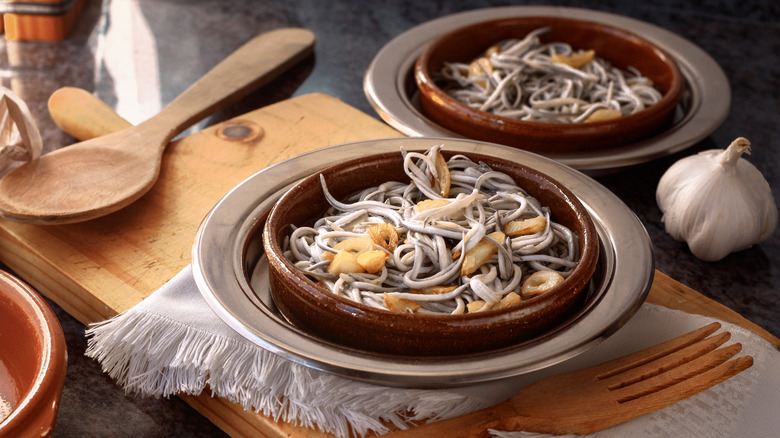The Expensive Spanish Delicacy That Will Make You Look Twice
Noodles are found throughout world cuisines, and for a good reason — they're comforting, affordable, mild, and versatile enough to suit an endless variety of dishes from soups to stir-fries. Noodles are made of pasta or other types of dough and come in various shapes and sizes. But if you're watching your carbs or can't partake in pasta dishes, many options emulate these squiggly strings of goodness.
Consider trendy spaghetti squash, which conveniently halves into two bowls of a vegetable-like version of pasta, zucchini noodles (zoodles), and shirataki — made with the fiber of the konjac plant, according to Food Network. Even a noodle made with strips of tripe has a unique texture that is said to be superb for holding sauce (per MasterClass). But then, in a league of its own, there's a Basque delicacy masquerading as a hearty pasta dish that might just make you do a double take
In angulas, the noodles were alive
Every type of noodle has always been pretty interactive. They're laborious to make, and when you eat them, it's hands-on: you slurp them up and twirl them onto utensils in a gastronomical spectacle. But in the dish called angulas, you look the noodles in the face — because they're actually baby eels. According to BBC, the young glass eels — or elvers — are born under enigmatic circumstances and eagerly harvested off the shores of the Atlantic Ocean during the roughest, coldest time of the year and enjoyed over the winter holidays.
Elvers are slender, silvery-white, and similar in appearance to udon noodles. So, what's a mouthful of little eels like? BBC reports that elvers taste about as mellow as their starchy counterparts, so they're often tossed in with fried garlic and hot peppers and cooked in earthenware pots. Per BBC, they're alleged to have very little flavor or smell, seemingly prized most for their slick, somewhat crunchy texture and cultural significance: so much that they're often smuggled.
Homemade angulas recipes
Before you dash off to buy elvers for your homemade angulas, know that they're one of the most expensive foods in Spain (per BBC), selling for hundreds of dollars a pound. Food Manufacturing explains that supply chain stressors like the COVID-19 pandemic, international trade issues, and high demand for Asian fish farming and culinary applications have increased prices. If you're determined, you can order them from online purveyors or specialty seafood markets.
Chefs and restaurants have contributed to the continued popularity of elves, with recipes such as baby eels in garlic sauce and baby eels in casserole. An alternative called gulas, BBC writes, is made from surimi (imitation crab) that's become an incredibly popular substitute. You can cook gulas like real eels or use them in surimi recipes like crab salad, soups, stir-fries, and sushi. And you may well want to — not only are baby eels expensive, but they're also a threatened species (per The Nature Conservatory). So next time you're about to dig into a big bowl of noodles, know that somewhere in the world, they were once wiggling through the ocean and into gastronomes' hearts.


